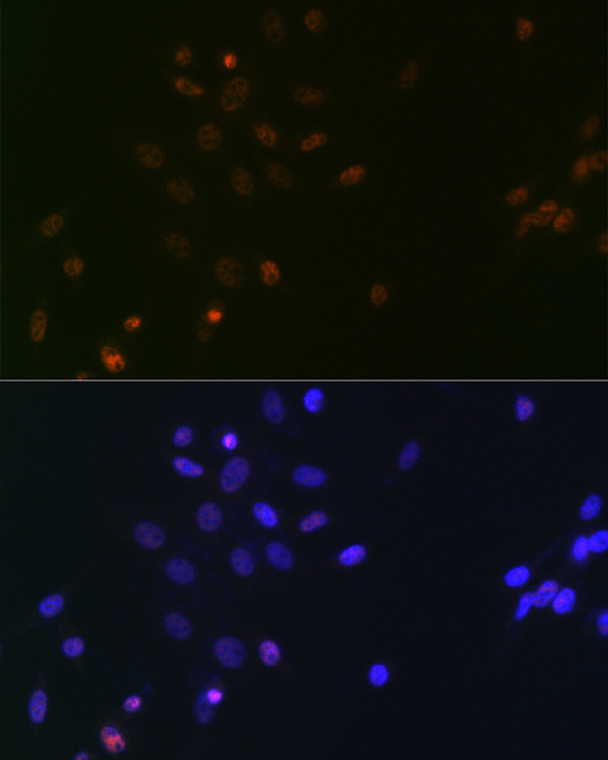| Host: |
Rabbit |
| Applications: |
WB/IHC/IF |
| Reactivity: |
Human/Mouse/Rat |
| Note: |
STRICTLY FOR FURTHER SCIENTIFIC RESEARCH USE ONLY (RUO). MUST NOT TO BE USED IN DIAGNOSTIC OR THERAPEUTIC APPLICATIONS. |
| Short Description: |
Rabbit monoclonal antibody anti-SUPT5H/SPT5 (800-900) is suitable for use in Western Blot, Immunohistochemistry and Immunofluorescence research applications. |
| Clonality: |
Monoclonal |
| Clone ID: |
S7MR |
| Conjugation: |
Unconjugated |
| Isotype: |
IgG |
| Formulation: |
PBS with 0.02% Sodium Azide, 0.05% BSA, 50% Glycerol, pH7.3. |
| Purification: |
Affinity purification |
| Dilution Range: |
WB 1:500-1:1000IHC-P 1:50-1:200IF/ICC 1:50-1:200 |
| Storage Instruction: |
Store at-20°C for up to 1 year from the date of receipt, and avoid repeat freeze-thaw cycles. |
| Gene Symbol: |
SUPT5H |
| Gene ID: |
6829 |
| Uniprot ID: |
SPT5H_HUMAN |
| Immunogen Region: |
800-900 |
| Immunogen: |
A synthetic peptide corresponding to a sequence within amino acids 800-900 of human SUPT5H/SPT5 (O00267). |
| Immunogen Sequence: |
PHYGSQTPLHDGSRTPAQSG AWDPNNPNTPSRAEEEYEYA FDDEPTPSPQAYGGTPNPQT PGYPDPSSPQVNPQYNPQTP GTPAMYNTDQFSPYAAPSPQ G |
| Tissue Specificity | Ubiquitously expressed. |
| Post Translational Modifications | Methylated by PRMT1/HRMT1L2 and PRMT5/SKB1. Methylation negatively regulates interaction with P-TEFb and RNA polymerase II. Phosphorylated by CDK7 and CDK9. Phosphorylation by P-TEFb alleviates transcriptional pausing and can stimulate transcriptional elongation from the HIV-1 LTR. P-TEFb dependent phosphorylation is stimulated by the HIV-1 Tat protein. Phosphorylation may also stimulate interaction with PIN1. Bulk phosphorylation occurs predominantly in mitosis. |
| Function | Component of the DRB sensitivity-inducing factor complex (DSIF complex), which regulates mRNA processing and transcription elongation by RNA polymerase II. DSIF positively regulates mRNA capping by stimulating the mRNA guanylyltransferase activity of RNGTT/CAP1A. DSIF also acts cooperatively with the negative elongation factor complex (NELF complex) to enhance transcriptional pausing at sites proximal to the promoter. Transcriptional pausing may facilitate the assembly of an elongation competent RNA polymerase II complex. DSIF and NELF promote pausing by inhibition of the transcription elongation factor TFIIS/S-II. TFIIS/S-II binds to RNA polymerase II at transcription pause sites and stimulates the weak intrinsic nuclease activity of the enzyme. Cleavage of blocked transcripts by RNA polymerase II promotes the resumption of transcription from the new 3' terminus and may allow repeated attempts at transcription through natural pause sites. DSIF can also positively regulate transcriptional elongation and is required for the efficient activation of transcriptional elongation by the HIV-1 nuclear transcriptional activator, Tat. DSIF acts to suppress transcriptional pausing in transcripts derived from the HIV-1 LTR and blocks premature release of HIV-1 transcripts at terminator sequences. |
| Protein Name | Transcription Elongation Factor Spt5Hspt5Drb Sensitivity-Inducing Factor 160 Kda SubunitDsif P160Drb Sensitivity-Inducing Factor Large SubunitDsif Large SubunitTat-Cotransactivator 1 ProteinTat-Ct1 Protein |
| Database Links | Reactome: R-HSA-112382Reactome: R-HSA-113418Reactome: R-HSA-167152Reactome: R-HSA-167158Reactome: R-HSA-167160Reactome: R-HSA-167200Reactome: R-HSA-167238Reactome: R-HSA-167242Reactome: R-HSA-167243Reactome: R-HSA-167246Reactome: R-HSA-167287Reactome: R-HSA-167290Reactome: R-HSA-674695Reactome: R-HSA-6796648Reactome: R-HSA-6807505Reactome: R-HSA-72086Reactome: R-HSA-75955Reactome: R-HSA-77075 |
| Cellular Localisation | Nucleus |
| Alternative Antibody Names | Anti-Transcription Elongation Factor Spt5 antibodyAnti-Hspt5 antibodyAnti-Drb Sensitivity-Inducing Factor 160 Kda Subunit antibodyAnti-Dsif P160 antibodyAnti-Drb Sensitivity-Inducing Factor Large Subunit antibodyAnti-Dsif Large Subunit antibodyAnti-Tat-Cotransactivator 1 Protein antibodyAnti-Tat-Ct1 Protein antibodyAnti-SUPT5H antibodyAnti-SPT5 antibodyAnti-SPT5H antibody |
Information sourced from Uniprot.org
12 months for antibodies. 6 months for ELISA Kits. Please see website T&Cs for further guidance












